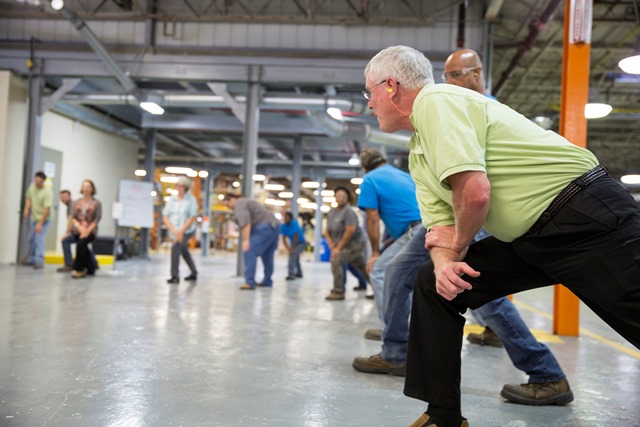Benefits of Workplace Stretching
STRETCHING ESSENTIALS
Basic Stretches to improve your flexibly should focus on the following major muscle groups of the body: calf, quadriceps, hamstrings, hip, back, neck, shoulder, and arms.
- Hold each stretch: Hold each stretch for at least 15 seconds and up to 30 seconds for really tight muscles or problem areas. If you hold the stretches for at least 30 seconds, you’ll need to do each stretch only once. You will know when you are done with that area, when you feel the muscles in that area start to relax.
- Don’t bounce: Bouncing as you stretch can lead to injuries. It causes small tears (microtears) in the muscle, which leaves scar tissue as the muscle heals. The scar tissue tightens the muscle even further, causing more inflexibility and making you more prone to pain.
- Focus on a pain-free stretch: If you feel pain as you stretch, you’ve gone too far. Back off to the point where you don’t feel any pain.
- Relax and breathe freely: Breathing must be slow, rhythmic, and controlled.
- Stretch before and after: Light stretching before the start of your day should be followed up with a more thorough stretching regimen after your day is complete.
- Warm your muscles: Use brisk exercise like walking or a warm shower or bath before stretching.
WHY DO YOU NEED TO STRETCH
The goal of stretching is to improve or maintain the range of motion in your joints and muscles.
Proper stretching lengthens muscle tissue, making it more flexible, and can lower your risk of injury. In addition, stretching can reduce muscle tension, improve coordination, develop awareness, promote circulation, and most importantly, a proper stretching routine feels good and can be a relaxing part of your day.
As you age, muscle shortening will gradually change your joint position and stride length. This causes much of the chronic, insidious damage to ligaments which results in changes in joint position and posture. Most of the constant, low-level inflammation and pain in people’s muscles and joints is the result of how people function, NOT how old they are. To help combat the effects of aging, you must stay active and be mindful of your health
BENEFITS OF STRETCHING
The following are some of the potential benefits from adding a stretching routine:
- Increased Flexibility: Flexible muscles can improve your daily performance.
- Improved Circulation: Increased blood flow to the muscles helps promote recovery.
- Better Posture: Having proper body alignment will reduce injuries and joint discomfort.
- Stress Relief: Reduces and relaxes tight muscles, especially in times of stress.
- Enhanced Coordination: Maintaining the full range of motion through your joints keeps you in better balance, especially as you get older.
NO GYM REQUIRED
Stretching is something you can easily do anytime.
Even if you are not a regular exerciser, you can still benefit from a regular stretching routine. Try to stretch at least once a day to maintain or increase flexibility.
Resources: www.mayoclinic.com; www.csm.org; www.nata.org

